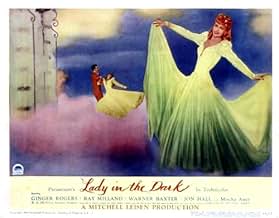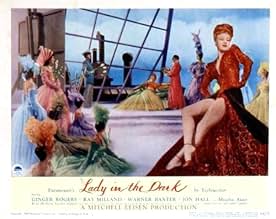CALIFICACIÓN DE IMDb
5.9/10
610
TU CALIFICACIÓN
Agrega una trama en tu idiomaLiza Elliott, "Allure" magazines editor-in-chief, suffers from headaches and continuous daydreams and undergoes psychoanalysis to determine why.Liza Elliott, "Allure" magazines editor-in-chief, suffers from headaches and continuous daydreams and undergoes psychoanalysis to determine why.Liza Elliott, "Allure" magazines editor-in-chief, suffers from headaches and continuous daydreams and undergoes psychoanalysis to determine why.
- Dirección
- Guionistas
- Elenco
- Nominado a 3 premios Óscar
- 1 premio ganado y 3 nominaciones en total
Opiniones destacadas
A Technicolor spectacular, with costumes and wonderful sets to match, but the story isn't much, mostly what you might expect to read in Popular Psychoanalysis magazine.
Best are the dream and reverie sequences, especially the trial in the circus ring. These are where the singing and dancing is, but there is not much and what little there is is not very exciting.
Best are the dream and reverie sequences, especially the trial in the circus ring. These are where the singing and dancing is, but there is not much and what little there is is not very exciting.
"Lady in the Dark" from 1944 is an adaptation of the Broadway musical of the same name, which starred Gertrude Lawrence and made a star out of Danny Kaye. Mischa Auer, Jon Hall, Ray Milland, and Gail Russell. Auer is in Kaye's role, and his show-stopping number, "Tchaikovsky" was cut.
Actually, the music in this version is incidental to the film. Ginger Rogers plays Liza, the editor of a fashion magazine. She sees a doctor because of headaches and inability to concentrate. He sends her to a psychiatrist (Barry Sullivan).
Psychology and psychiatry really hit their stride during World War II for obvious reasons. Though "Lady in the Dark" is dated in its views toward women, the unraveling of Liza's psyche through musical dreams is very entertaining.
Ginger Rogers is spectacular - a beautiful actress and dancer, she radiates light in her gorgeous gowns, which belie her normal non-dream office attire. She gives a touching performance of a conflicted, unhappy woman who can't embrace life but doesn't understand why.
Ray Milland is charming and funny as Charley, Liza's office nemesis, and Mischa Auer as the temperamental photographer is excellent. Jon Hall and Warner Baxter are very good, but their characters don't have the development of the other roles.
Probably the 1954 Lady in the Dark starring Ann Sothern is better and truer to the show. This Lady is worth seeing for Ginger.
Actually, the music in this version is incidental to the film. Ginger Rogers plays Liza, the editor of a fashion magazine. She sees a doctor because of headaches and inability to concentrate. He sends her to a psychiatrist (Barry Sullivan).
Psychology and psychiatry really hit their stride during World War II for obvious reasons. Though "Lady in the Dark" is dated in its views toward women, the unraveling of Liza's psyche through musical dreams is very entertaining.
Ginger Rogers is spectacular - a beautiful actress and dancer, she radiates light in her gorgeous gowns, which belie her normal non-dream office attire. She gives a touching performance of a conflicted, unhappy woman who can't embrace life but doesn't understand why.
Ray Milland is charming and funny as Charley, Liza's office nemesis, and Mischa Auer as the temperamental photographer is excellent. Jon Hall and Warner Baxter are very good, but their characters don't have the development of the other roles.
Probably the 1954 Lady in the Dark starring Ann Sothern is better and truer to the show. This Lady is worth seeing for Ginger.
For just three minutes towards the end of this overproduced travesty of Moss Hart's 1941 Broadway hit we finally get a hint of what might have been, when Ginger Rogers (a coarse substitute for Gertrude Lawrence, who declined to submit to the indignity of testing for the part) is finally allowed to sing a song from Kurt Weill & Ira Gershwin's acclaimed score - the magnificent 'Saga of Jenny' - the only song from the original production to make it into the film. (The flashbacks to her childhood and youth that follow actually manage to be quite touching.)
At $2.6million the most expensive film yet made by Paramount, at the box office the studio received a handsome return on its investment. But the hectoring misogyny that makes this film almost unwatchable today is probably just one reason that nobody has ever bothered to do a decent restoration of the film, so we really don't get the full benefit of the Oscar-nominated Technicolor photography and art direction that wowed critics and audiences back in 1944.
Ray Milland is excruciatingly misused as a charmless boor who Ginger is required by the script eventually to fall into the arms of (Cary Grant might just have pulled it off), and her rejection of Warner Baxter and Jon Hall for being insufficiently Alpha is just another twist of the knife of the already unpleasant sexual politics of this piece. (Ginger, by the way, actually looks pretty cool to my eyes in her 'unattractive' mannish suits.)
But at least we don't get Danny Kaye's mugging from the Broadway original as the camp fashion photographer Russell Paxton (Mischa Auer is a far more agreeable substitute), and are spared his 'hilarious' patter song 'Tschaikowsky (and Other Russians)'.
Mary Phillips does her best in an underwritten part (as indeed are most of them). Edward Fielding, by the way, who plays Ginger's physician in the opening sequence, also appeared uncredited as Dr. Edwardes in the dream sequence of Hitchcock's 'Spellbound' (1945), Hollywood's other high profile exercise in cod psychology from this era.
At $2.6million the most expensive film yet made by Paramount, at the box office the studio received a handsome return on its investment. But the hectoring misogyny that makes this film almost unwatchable today is probably just one reason that nobody has ever bothered to do a decent restoration of the film, so we really don't get the full benefit of the Oscar-nominated Technicolor photography and art direction that wowed critics and audiences back in 1944.
Ray Milland is excruciatingly misused as a charmless boor who Ginger is required by the script eventually to fall into the arms of (Cary Grant might just have pulled it off), and her rejection of Warner Baxter and Jon Hall for being insufficiently Alpha is just another twist of the knife of the already unpleasant sexual politics of this piece. (Ginger, by the way, actually looks pretty cool to my eyes in her 'unattractive' mannish suits.)
But at least we don't get Danny Kaye's mugging from the Broadway original as the camp fashion photographer Russell Paxton (Mischa Auer is a far more agreeable substitute), and are spared his 'hilarious' patter song 'Tschaikowsky (and Other Russians)'.
Mary Phillips does her best in an underwritten part (as indeed are most of them). Edward Fielding, by the way, who plays Ginger's physician in the opening sequence, also appeared uncredited as Dr. Edwardes in the dream sequence of Hitchcock's 'Spellbound' (1945), Hollywood's other high profile exercise in cod psychology from this era.
I like this movie. It is confusing and difficult, but you can't help but like it. Ginger Rogers plays a fashion magazine editor...and she finds herself having headaches and feeling dissatisfied. This makes no sense, as she has an exceptional job (especially for 1940) three suitors, and conscious and unconscious lives that are fabulously costumed. She goes to her doctor who recommends a psychiatrist...a drastic move for the time...which she promptly declines...but then does finally go to. Ginger undergoes a great deal of stress in this film,and keeping a bottle of aspirin at hand might be wise. As she makes progress with her shrink...her dream sequences become more and more lavish. The film is beautifully costumed...even clothes left lying on a chair...are fabulous. And there are HATS. HATS. Hats... mousey through military...lots of hats...and FURS...Ginger has one dress with a floor length mink skirt...lined with gold and scarlet sequins, two or three fur coats, a muff, and several other dresses trimmed with fur. Pull the shades and make certain that no one from PETA is around when you run this film. The dream sequences are the real meat of this...they are very beautiful and very surreal. In the end, of course, Ginger selects one of the men (no, not the married one) and seems to be on the road to recovery. You get the feeling that a lot got left out...and I don't know what (yet). I know Danny Kaye was 'discovered' in the Broadway show...and that he had special material. Danny was under contract to Sam Goldwyn by the time this was made...so neither he nor any of his special material made the transition into this film. This film is a visual knock out...and a restored print should be made and hi-def DVD's struck...so we can watch this from time to time. It cannot help but remain dated and politically incorrect....that is the legacy of its 1940 dateline.. but it will certainly always be stunning to look at.
The lady is in the 'dark' about being a lesbian. Oh why can't somebody just say it. I guess you could on Broadway and with Gertrude Lawrence in 1940 but at Paramount in '44 with Ginger, well, she just had to stay in the dark and have repressed sexual dreams about her fur in a cage and her eggs at a circus (see the Jenny number) ... and see that dress she unfurls.. a vagina representation of ever I saw one on a movie screen that wasn't x rated. In this ultra glamorous dreamy musical film Ginger is a business woman in business attire (read: lesbian .....) and she is tormented between her real business and society's demands that she marry and be with a man. Hence dilemma, dreams and fur openings and the egg circus (see the Jenny number) ... the storyline demands she relate to a man when she does not want to hence the dream sequences of antagonism and sexual wonderings. Ray Milland is the sop she is deemed to marry when anyone from this century can see she really wants to stay in a women's world and stop being a frustrated big angry prowling pussy in a cage (see the Jenny number) .... Kurt Weill knew what he was on about and so do we... but Paramount, in masking it for the masses in '44 pushed the pussycat into the fantasy sequences, hired a gay director and let loose on the dreams and shot the lot in the best most stylish Technicolor you ever saw outside of YOLANDA AND THE THIEF and THE PIRATE. In this according to Paramount, all Ginger needed was a jolly good roger.... ing.....
¿Sabías que…?
- TriviaThis was one of the first films to use the word "sex." Ray Milland says, "Rage is a pretty good substitute for sex, isn't it?"
- Citas
Russell Paxton: "This is the end! The absolute end!"
- Créditos curiososAt the start of the film the Paramount logo is set at night, in the dark.
At the end of the film the Paramount logo is seen at dawn, come into the light.
- ConexionesReferenced in Libros Famosos (1946)
- Bandas sonorasMain Title
Music by James Jimmy Van Heusen and Lyrics by Johnny Burke
Performed by the Paramount Studio Orchestra and Chorus
Selecciones populares
Inicia sesión para calificar y agrega a la lista de videos para obtener recomendaciones personalizadas
- How long is Lady in the Dark?Con tecnología de Alexa
Detalles
- Fecha de lanzamiento
- País de origen
- Idioma
- También se conoce como
- Lady in the Dark
- Locaciones de filmación
- Productora
- Ver más créditos de la compañía en IMDbPro
- Tiempo de ejecución
- 1h 40min(100 min)
- Relación de aspecto
- 1.37 : 1
Contribuir a esta página
Sugiere una edición o agrega el contenido que falta



































